茶具

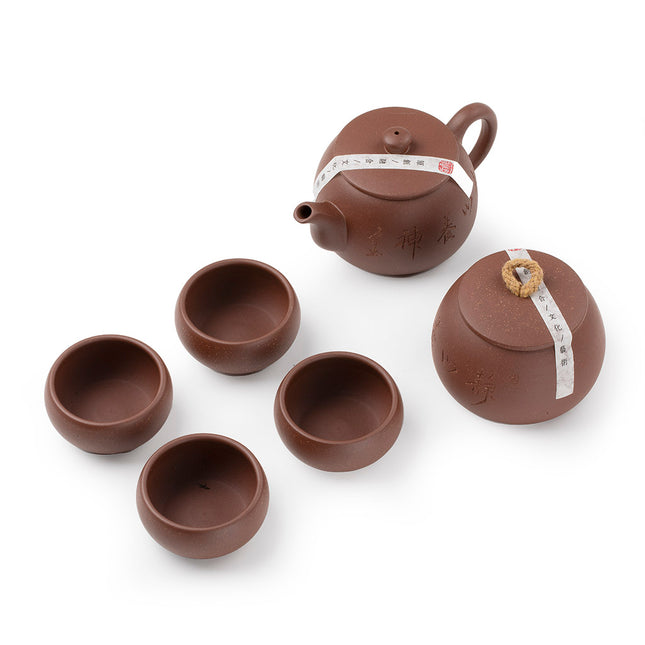
宜兴紫砂 一陶一社六頭 靜心養神套組
宜兴紫砂 一陶一社六頭 靜心養神套組 200ml 尺寸/size (inch) 茶壶 Tea pot with lid: 5.5 * 3.5 * 2.8 /1pcs 茶杯 Tea cups: 2.5* 1.2 /4 pcs 茶海 Fairness Cup with lid: 3.3* 2.3 /1pcs Yixing Clay (Zi Sha) Tea Set 6 Pieces The Yixing pronounced (E-Shing) teapot was the first vessel designed specifically for brewing tea during the Ming dynasty (1368 – 1644). The first Yixing teapots originated west of Taihu, the great lake in the Jiangsu province around 100 miles from Shanghai. ... Pottery has been produced in Yixing since neolithic times. Yixing teapots are intended for pu’er, black, and oolong teas. They can also be used for green or white teas, however, the heat retention characteristics of Yixing make the brewing process extremely difficult; and in such cases, the water must be heated to no greater than 85 °C (185 °F), before pouring into the teapot. A famous characteristic of Yixing teapots is their ability to absorb trace amounts of brewed tea flavors and minerals into the teapot with each brewing. Over time, these accumulate to give each Yixing teapot its own unique interior coating that flavors and colors future brewings. It is for this reason that soap is never recommended for cleaning Yixing teapots, but instead, fresh distilled water and air drying. Many tea connoisseurs will steep only one type of tea in a particular Yixing teapot so that future brewings of the same type of tea will be optimally enhanced Yixing teapots are smaller than their western counterparts as the tea is often brewed using the gongfu style of brewing: shorter steeping durations with smaller amounts of water and smaller teacups (compared to western-style brewing). Traditionally, the tea from the teapot is poured into either a small pitcher, from which it is then poured into a teacup that holds approximately 30 ml or less of liquid, allowing the tea to be quickly and repeatedly ingested before it becomes cooled or into several teacups for guests. (Wikipedia)
$199.99

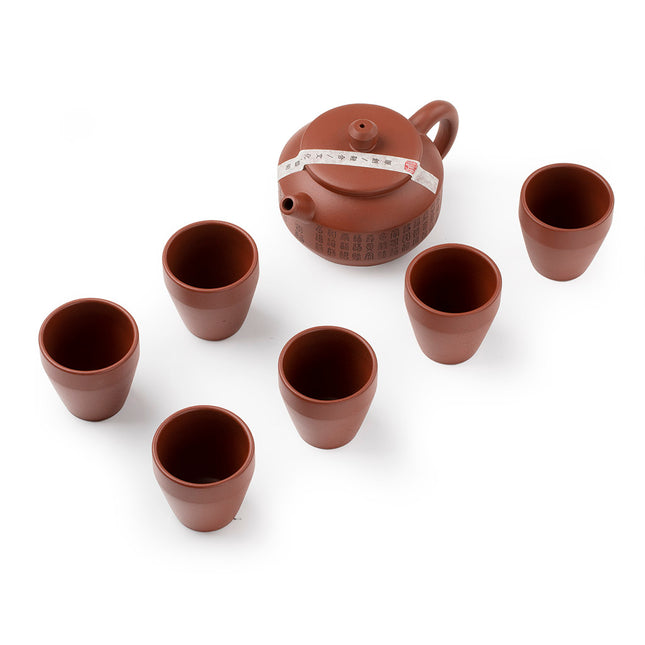
宜兴紫砂 一陶一社 七頭百福套組 200ml
宜兴紫砂 一陶一社 七頭百福套組 200ml 尺寸/size (inch) 茶壶 Tea pot with lid: 5 * 3.5 * 2.8 /1pcs 茶杯 Tea cups: 2.1* 2.1 /6 pcs Yixing Clay (Zi Sha) Tea Set 7 Pieces The Yixing pronounced (E-Shing) teapot was the first vessel designed specifically for brewing tea during the Ming dynasty (1368 – 1644). The first Yixing teapots originated west of Taihu, the great lake in the Jiangsu province around 100 miles from Shanghai. ... Pottery has been produced in Yixing since neolithic times. Yixing teapots are intended for pu’er, black, and oolong teas. They can also be used for green or white teas, however, the heat retention characteristics of Yixing make the brewing process extremely difficult; and in such cases, the water must be heated to no greater than 85 °C (185 °F), before pouring into the teapot. A famous characteristic of Yixing teapots is their ability to absorb trace amounts of brewed tea flavors and minerals into the teapot with each brewing. Over time, these accumulate to give each Yixing teapot its own unique interior coating that flavors and colors future brewings. It is for this reason that soap is never recommended for cleaning Yixing teapots, but instead, fresh distilled water and air drying. Many tea connoisseurs will steep only one type of tea in a particular Yixing teapot so that future brewings of the same type of tea will be optimally enhanced Yixing teapots are smaller than their western counterparts as the tea is often brewed using the gongfu style of brewing: shorter steeping durations with smaller amounts of water and smaller teacups (compared to western-style brewing). Traditionally, the tea from the teapot is poured into either a small pitcher, from which it is then poured into a teacup that holds approximately 30 ml or less of liquid, allowing the tea to be quickly and repeatedly ingested before it becomes cooled or into several teacups for guests. (Wikipedia)
$159.99

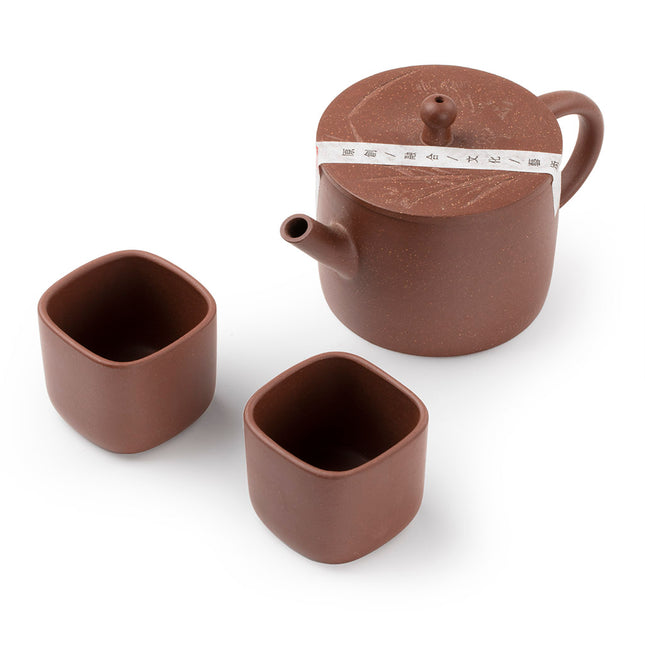
宜兴紫砂 一陶一社 蘭韻套組 200ml
宜兴紫砂 一陶一社 蘭韻套組 200ml 尺寸/size (inch) 茶壶 Tea pot with lid: 5 * 3 * 2.8 /1pcs 茶杯 Tea cups: 1.8 * 1.6 /2 pcs Yixing Clay (Zi Sha) Tea Set 3 Pieces The Yixing pronounced (E-Shing) teapot was the first vessel designed specifically for brewing tea during the Ming dynasty (1368 – 1644). The first Yixing teapots originated west of Taihu, the great lake in the Jiangsu province around 100 miles from Shanghai. ... Pottery has been produced in Yixing since neolithic times. Yixing teapots are intended for pu’er, black, and oolong teas. They can also be used for green or white teas, however, the heat retention characteristics of Yixing make the brewing process extremely difficult; and in such cases, the water must be heated to no greater than 85 °C (185 °F), before pouring into the teapot. A famous characteristic of Yixing teapots is their ability to absorb trace amounts of brewed tea flavors and minerals into the teapot with each brewing. Over time, these accumulate to give each Yixing teapot its own unique interior coating that flavors and colors future brewings. It is for this reason that soap is never recommended for cleaning Yixing teapots, but instead, fresh distilled water and air drying. Many tea connoisseurs will steep only one type of tea in a particular Yixing teapot so that future brewings of the same type of tea will be optimally enhanced Yixing teapots are smaller than their western counterparts as the tea is often brewed using the gongfu style of brewing: shorter steeping durations with smaller amounts of water and smaller teacups (compared to western-style brewing). Traditionally, the tea from the teapot is poured into either a small pitcher, from which it is then poured into a teacup that holds approximately 30 ml or less of liquid, allowing the tea to be quickly and repeatedly ingested before it becomes cooled or into several teacups for guests. (Wikipedia)
$159.99

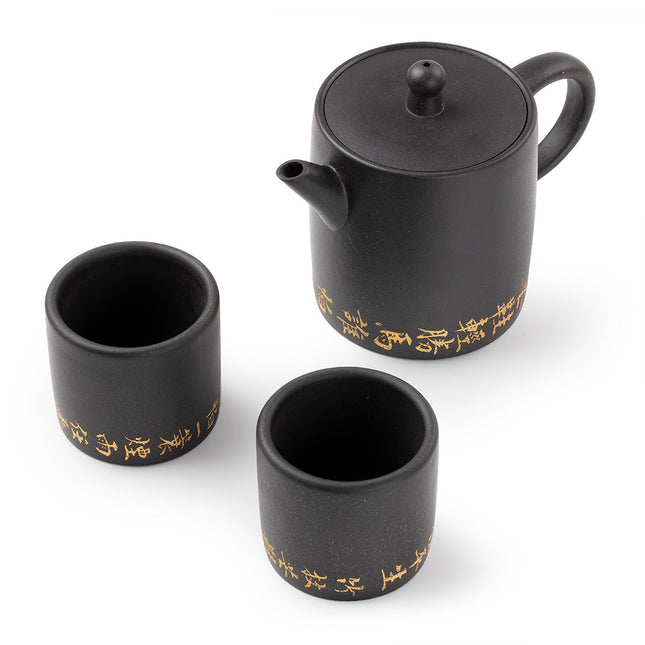
宜兴紫砂 一陶一社 真意套組 200ml
宜兴紫砂 一陶一社 真意套組 200ml 尺寸/size (inch) 茶壶 Tea pot with lid: 4.9 * 2.7 * 3.5 /1pcs 茶杯 Tea cups: 2 * 1.8 /2 pcs Yixing Clay (Zi Sha) Tea Set 3 Pieces The Yixing pronounced (E-Shing) teapot was the first vessel designed specifically for brewing tea during the Ming dynasty (1368 – 1644). The first Yixing teapots originated west of Taihu, the great lake in the Jiangsu province around 100 miles from Shanghai. ... Pottery has been produced in Yixing since neolithic times. Yixing teapots are intended for pu’er, black, and oolong teas. They can also be used for green or white teas, however, the heat retention characteristics of Yixing make the brewing process extremely difficult; and in such cases, the water must be heated to no greater than 85 °C (185 °F), before pouring into the teapot. A famous characteristic of Yixing teapots is their ability to absorb trace amounts of brewed tea flavors and minerals into the teapot with each brewing. Over time, these accumulate to give each Yixing teapot its own unique interior coating that flavors and colors future brewings. It is for this reason that soap is never recommended for cleaning Yixing teapots, but instead, fresh distilled water and air drying. Many tea connoisseurs will steep only one type of tea in a particular Yixing teapot so that future brewings of the same type of tea will be optimally enhanced Yixing teapots are smaller than their western counterparts as the tea is often brewed using the gongfu style of brewing: shorter steeping durations with smaller amounts of water and smaller teacups (compared to western-style brewing). Traditionally, the tea from the teapot is poured into either a small pitcher, from which it is then poured into a teacup that holds approximately 30 ml or less of liquid, allowing the tea to be quickly and repeatedly ingested before it becomes cooled or into several teacups for guests. (Wikipedia)
$159.99

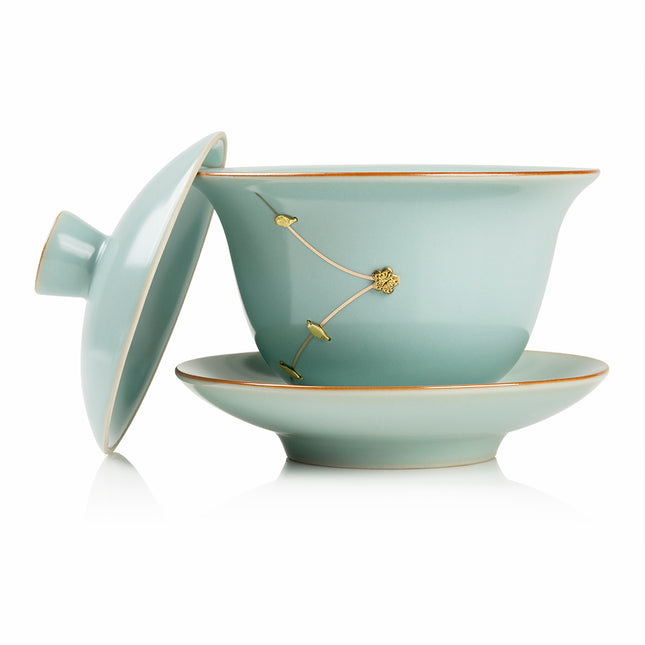
汝窯天青色鋦釘蓋碗
汝窯天青色鋦釘蓋碗 Size(Inch) 茶杯盖 teacup lid: 3.5*3.5*1.3 茶杯 Tea cup: 4 * 4 * 2.3 托盘 Tray: 4.2*4.2*0.8 Ru ware is a famous and extremely rare type of Chinese pottery originally from the Song dynasty, produced for the imperial court for a brief period around 1100. This type of porcelain is smooth and elegant to touch. It has a sleek, bright, and simple design with a beautiful finish. This exquisite celadon's fine patina of hairline cracks is an especially prized characteristic that enhances its aesthetic appeal. Celadon ware has a soft grey-green-colored glaze achieved by applying an iron-rich liquefied clay to the ceramic before it is fired in a kiln. The cup looks delicate but is durable. With use over time, the appearance of the cracks in Ru-Kiln ware darkens to enhance the beautiful patterns. The cup with lid and tray is a traditional way of enjoying warm tea in China and pays respect to the tea and the tea drinker. It makes an especially fine gift. Since they are hand-crafted, each individual cup is unique in glaze, shape, and volume. Ru-kiln porcelain has a soft hand feel, a sleek, bright, and simple design but elegant gross finished looking. The sidewall is thin but durable. each piece of this tea set has an inconspicuous ice crack pattern on it which can only be seen when taking a close look.汝窯瓷器手感柔軟,造型圓潤亮麗,造型簡潔大方。側壁很薄但很耐用。每件茶具上都有不顯眼的冰裂紋圖案,只有仔細觀察才能看到。This is a handmade item, and every cup will vary slightly in glaze, shape, dimensions, and volume. White Ru kiln teacup with a hand-painted cat theme and crackle glaze finish.這是一件手工製品,每個杯子的釉料、形狀、尺寸和體積都會略有不同。白汝窯茶杯,手繪貓主題,裂紋釉面。These Cups are covered with a web of craquelure: hairline cracks in the glaze that will darken with use. This natural patina is an especially prized characteristic of fine celadon, and adds to the pot's aesthetic appeal as every pot is different. Every cup has its own personality which gives us more surprises.這些杯子上覆蓋著一張龜甲網:釉料中的細線裂縫會隨著使用而變暗。這種天然的銅綠是精美青瓷的一個特別珍貴的特徵,並且由於每個陶器都不同,因此增加了陶器的審美情趣。每個杯子都有自己的個性,給我們更多的驚喜.Ru kiln glaze texture/color generation is uncontrollable, 汝窯釉質/顏色生成不可控, The difference of Ru-kiln between before and after:
$52.99

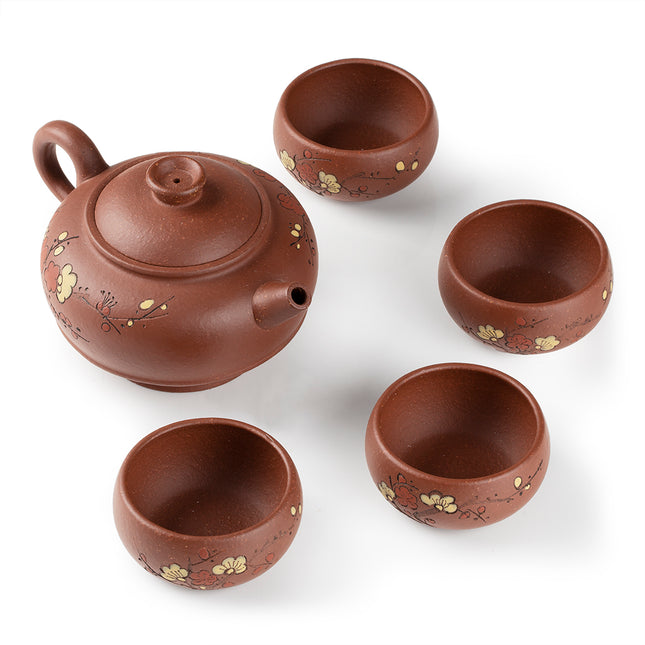
宜兴 紫砂原矿紫泥 暗香 虚扁壶 5头茶具200ml
宜兴 紫砂原矿紫泥 暗香 虚扁壶 5头茶具200ml Yixing Hand-made Purple Clay (Zi Sha) Tea Set Anxiang 茶壶 Tea pot(inch): 5.5 * 4 * 3 茶杯 Tea cup(inch): 2.5*2.5*1.5 * 4piece Yixing Hand-made Purple Clay (Zi Sha) Tea Set Anxiang Yixing teapots are intended for pu’er, black, and oolong teas. They can also be used for green or white teas, however, the heat retention characteristics of Yixing make the brewing process extremely difficult; and in such cases, the water must be heated to no greater than 85 °C (185 °F), before pouring into the teapot. A famous characteristic of Yixing teapots is their ability to absorb trace amounts of brewed tea flavors and minerals into the teapot with each brewing. Over time, these accumulate to give each Yixing teapot its own unique interior coating that flavors and colors future brewings. It is for this reason that soap is never recommended for cleaning Yixing teapots, but instead, fresh distilled water and air drying. Many tea connoisseurs will steep only one type of tea in a particular Yixing teapot so that future brewings of the same type of tea will be optimally enhanced Yixing teapots are smaller than their western counterparts as the tea is often brewed using the gongfu style of brewing: shorter steeping durations with smaller amounts of water and smaller teacups (compared to western-style brewing). Traditionally, the tea from the teapot is poured into either a small pitcher, from which it is then poured into a teacup that holds approximately 30 ml or less of liquid, allowing the tea to be quickly and repeatedly ingested before it becomes cooled or into several teacups for guests. (Wikipedia) Yixing has a long history as the “Pottery Capital” of China. It was there during the Ming Dynasty (1368-1644 CE) that the world's first teapots were created... First, when the tea is brewed in teapots made from the special “Zisha” (purple sand) clay, a tiny amount of tea is absorbed in the interior. That season the pot. The first Yixing teapots originated west of Taihu, the great lake in the Jiangsu province around 100 miles from Shanghai. They became a favorite of the Chinese intellectual class for their naturalism in both material and form. The distinctive reddish stoneware teapots came to be considered the best for brewing tea.
$96.90
- SALE

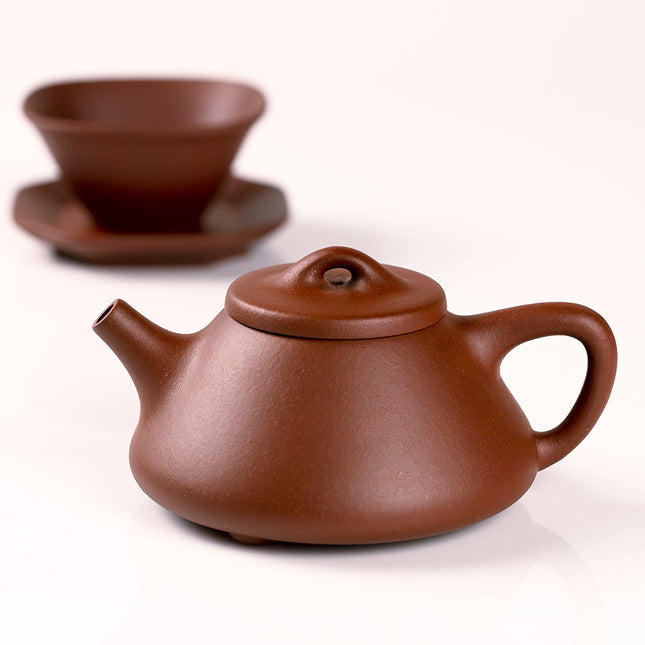
紫砂套組(一壺二杯碟)
紫砂套組(一壺二杯碟) Size(Inch) 茶壶 Tea pot: 4.5 * 3.5 * 2.2 茶杯 Tea cup: 2.7 * 2.7 *1.4 (2Pc) 茶盘 Tray: 3.2 * 3.2 * 0.4 (2Pc) YIXING PURPLE CLAY (ZI SHA) TEA SET 2 PIECES The Yixing pronounced (E-Shing) teapot was the first vessel designed specifically for brewing tea during the Ming dynasty (1368 – 1644). The first Yixing teapots originated west of Taihu, the great lake in the Jiangsu province around 100 miles from Shanghai. ... Pottery has been produced in Yixing since neolithic times. Yixing teapots are intended for pu-erh, black, and oolong teas. They can also be used for green or white teas, however, the heat retention characteristics of Yixing make the brewing process extremely difficult; and in such cases, the water must be heated to no greater than 85 °C (185 °F), before pouring into the teapot. A famous characteristic of Yixing teapots is their ability to absorb trace amounts of brewed tea flavors and minerals into the teapot with each brewing. Over time, these accumulate to give each Yixing teapot its own unique interior coating that flavors and colors future brewings. It is for this reason that soap is never recommended for cleaning Yixing teapots, but instead, fresh distilled water and air drying. Many tea connoisseurs will steep only one type of tea in a particular Yixing teapot so that future brewings of the same type of tea will be optimally enhanced Yixing teapots are smaller than their western counterparts as the tea is often brewed using the gongfu style of brewing: shorter steeping durations with smaller amounts of water and smaller teacups (compared to western-style brewing). Traditionally, the tea from the teapot is poured into either a small pitcher, from which it is then poured into a teacup that holds approximately 30 ml or less of liquid, allowing the tea to be quickly and repeatedly ingested before it becomes cooled or into several teacups for guests. (Wikipedia)
$129.99$119.99
- SALE

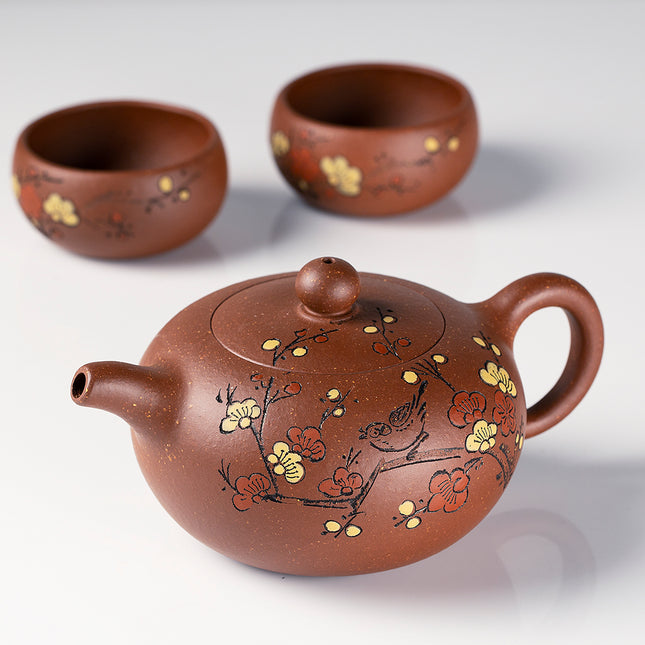
宜兴 紫砂老段泥 锦盒 暗香 圆珠壶 5头茶具200ml
宜兴 紫砂老段泥 锦盒 暗香 圆珠壶 5头茶具200ml 茶壶 Tea pot: 10cm*7cm/1pcs 茶杯 Tea cup:3cm*6cm/4pcs Yixing Hand-made Purple Clay (Zi Sha) Tea Set Anxiang Yixing teapots are intended for pu’er, black, and oolong teas. They can also be used for green or white teas, however, the heat retention characteristics of Yixing make the brewing process extremely difficult; and in such cases, the water must be heated to no greater than 85 °C (185 °F), before pouring into the teapot. A famous characteristic of Yixing teapots is their ability to absorb trace amounts of brewed tea flavors and minerals into the teapot with each brewing. Over time, these accumulate to give each Yixing teapot its own unique interior coating that flavors and colors future brewings. It is for this reason that soap is never recommended for cleaning Yixing teapots, but instead, fresh distilled water and air drying. Many tea connoisseurs will steep only one type of tea in a particular Yixing teapot so that future brewings of the same type of tea will be optimally enhanced. Yixing teapots are smaller than their western counterparts as the tea is often brewed using the gongfu style of brewing: shorter steeping durations with smaller amounts of water and smaller teacups (compared to western-style brewing). Traditionally, the tea from the teapot is poured into either a small pitcher, from which it is then poured into a teacup that holds approximately 30 ml or less of liquid, allowing the tea to be quickly and repeatedly ingested before it becomes cooled or into several teacups for guests. (Wikipedia) Yixing has a long history as the “Pottery Capital” of China. It was there during the Ming Dynasty (1368-1644 CE) that the world's first teapots were created... First, when the tea is brewed in teapots made from the special “Zisha” (purple sand) clay, a tiny amount of tea is absorbed in the interior. That season the pot. The first Yixing teapots originated west of Taihu, the great lake in the Jiangsu province around 100 miles from Shanghai. They became a favorite of the Chinese intellectual class for their naturalism in both material and form. The distinctive reddish stoneware teapots came to be considered the best for brewing tea.
$96.90$89.99
- 10% OFF

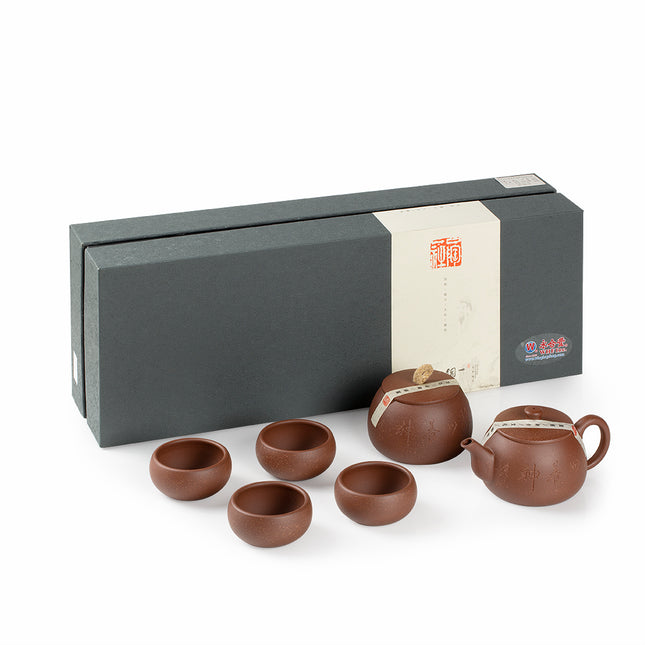
YIXING HAND-MADE PURPLE CLAY (ZI SHA) TEA SET ANXIANG 6 PIECES
宜兴紫砂6頭手工茶具 Size(Inch) 茶壶 Tea pot: 5.5* 3.5 * 2.6 茶杯 Tea cup: 2.5 * 2.5 * 1.3 (4Pc) 茶盘 Tray: 3.2 * 3.2 * 0.4 YIXING PURPLE CLAY (ZI SHA) TEA SET 2 PIECES The Yixing pronounced (E-Shing) teapot was the first vessel designed specifically for brewing tea during the Ming dynasty (1368 – 1644). The first Yixing teapots originated west of Taihu, the great lake in the Jiangsu province around 100 miles from Shanghai. ... Pottery has been produced in Yixing since neolithic times. Yixing teapots are intended for Pu-Erh, black, and oolong teas. They can also be used for green or white teas, however, the heat retention characteristics of Yixing make the brewing process extremely difficult; and in such cases, the water must be heated to no greater than 85 °C (185 °F), before pouring into the teapot. A famous characteristic of Yixing teapots is their ability to absorb trace amounts of brewed tea flavors and minerals into the teapot with each brewing. Over time, these accumulate to give each Yixing teapot its own unique interior coating that flavors and colors future brewings. It is for this reason that soap is never recommended for cleaning Yixing teapots, but instead, fresh distilled water and air drying. Many tea connoisseurs will steep only one type of tea in a particular Yixing teapot so that future brewings of the same type of tea will be optimally enhanced. Yixing teapots are smaller than their western counterparts as the tea is often brewed using the gongfu style of brewing: shorter steeping durations with smaller amounts of water and smaller teacups (compared to western-style brewing). Traditionally, the tea from the teapot is poured into either a small pitcher, from which it is then poured into a teacup that holds approximately 30 ml or less of liquid, allowing the tea to be quickly and repeatedly ingested before it becomes cooled or into several teacups for guests. (Wikipedia)
$179.99$159.99

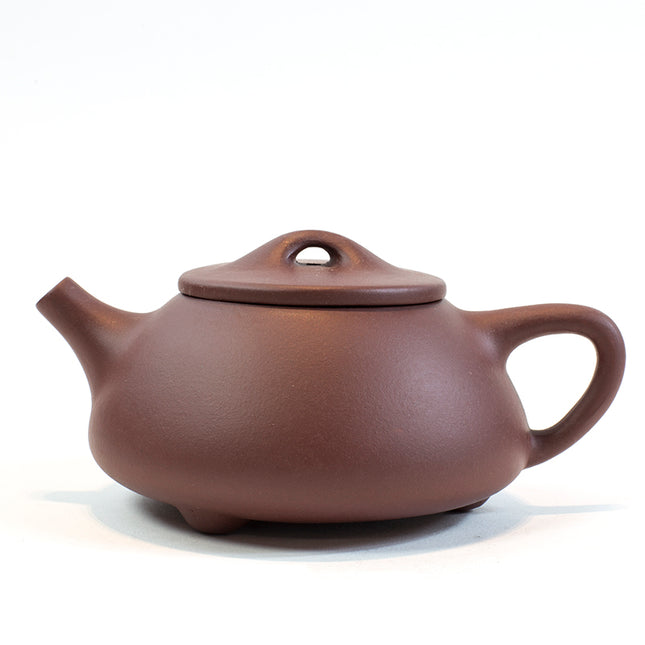
宜兴紫砂 石瓢壶 功夫茶壶 茶具套装
宜兴紫砂 石瓢壶 功夫茶壶 茶具套装 茶壶 Tea pot: 14* 11* 7 cm /1pcs 茶杯 Tea cups: 6* 3 cm /6 pcs 茶海 Fairness Cup: 11* 8* 5 cm /1pcs Yixing Purple Clay (Zi Sha) Tea Set 8 Pieces Shipiao The Yixing pronounced (E-Shing) teapot was the first vessel designed specifically for brewing tea during the Ming dynasty (1368 – 1644). The first Yixing teapots originated west of Taihu, the great lake in the Jiangsu province around 100 miles from Shanghai. ... Pottery has been produced in Yixing since neolithic times. Yixing teapots are intended for pu’er, black, and oolong teas. They can also be used for green or white teas, however, the heat retention characteristics of Yixing make the brewing process extremely difficult; and in such cases, the water must be heated to no greater than 85 °C (185 °F), before pouring into the teapot. A famous characteristic of Yixing teapots is their ability to absorb trace amounts of brewed tea flavors and minerals into the teapot with each brewing. Over time, these accumulate to give each Yixing teapot its own unique interior coating that flavors and colors future brewings. It is for this reason that soap is never recommended for cleaning Yixing teapots, but instead, fresh distilled water and air drying. Many tea connoisseurs will steep only one type of tea in a particular Yixing teapot so that future brewings of the same type of tea will be optimally enhanced Yixing teapots are smaller than their western counterparts as the tea is often brewed using the gongfu style of brewing: shorter steeping durations with smaller amounts of water and smaller teacups (compared to western-style brewing). Traditionally, the tea from the teapot is poured into either a small pitcher, from which it is then poured into a teacup that holds approximately 30 ml or less of liquid, allowing the tea to be quickly and repeatedly ingested before it becomes cooled or into several teacups for guests. (Wikipedia)
$208.90

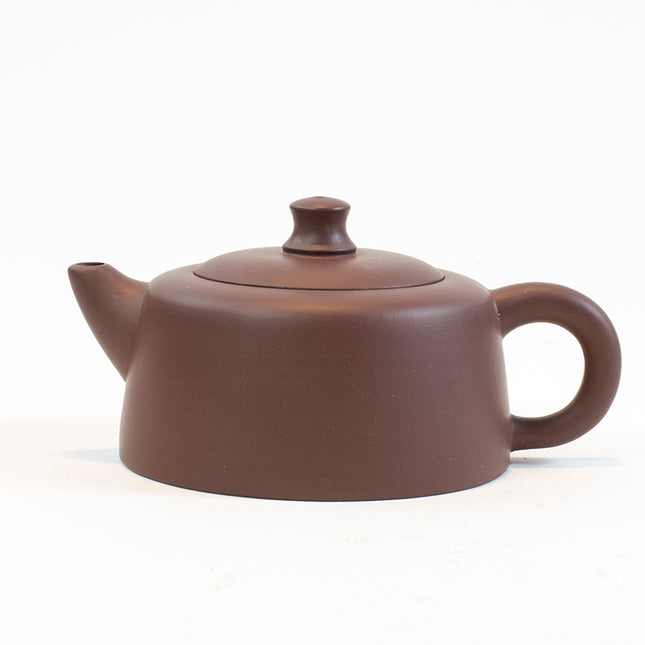
宜兴紫砂 天际壶 户外便携式 功夫茶壶 旅行茶具套装
宜兴紫砂 天际壶 户外便携式 功夫茶壶 旅行茶具套装 茶壶 Tea pot: 12.5*8.5*6 cm 150ml 茶杯 Tea cup: 6*3 cm 40ml 茶盘 Tray: 30*14*2 cm
$92.99

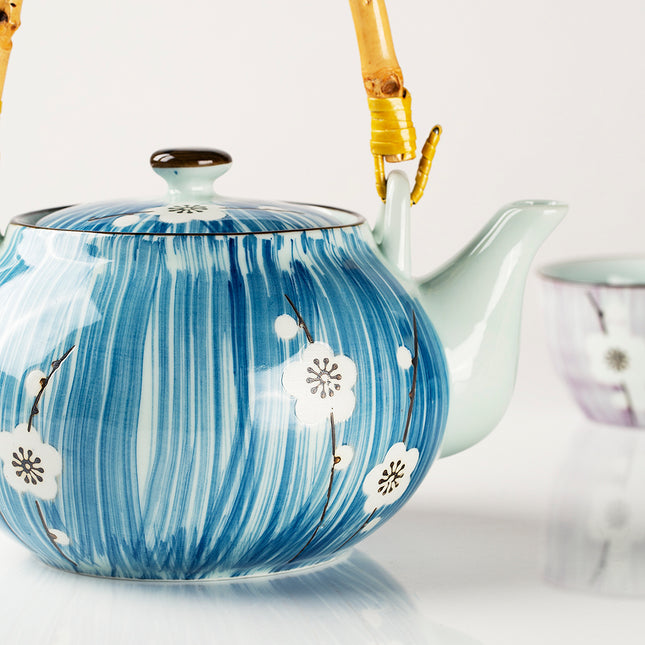
日本茶具五件套 TPS95
日本茶具六件套 Size(Inch) 茶壶 Tea pot: 6.5 * 5 * 3 茶杯 Tea cup: 3 * 3 * 2 (5Pc) Set of four teacups and tea pot packaged in a black gift box. What a great gift! Make in Japan.
$38.99
























